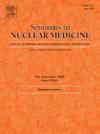Global experience in brain amyloid imaging
IF 5.9
2区 医学
Q1 RADIOLOGY, NUCLEAR MEDICINE & MEDICAL IMAGING
引用次数: 0
Abstract
Brain amyloid imaging has become a crucial tool in diagnosing and understanding Alzheimer's disease (AD) and related neurodegenerative disorders. The introduction of amyloid positron emission tomography (PET) with [¹¹C]Pittsburgh Compound-B ([¹¹C]PiB) in the early 2000s marked a breakthrough in visualizing amyloid-β (Aβ) deposition in vivo. Subsequent development of ¹⁸F-labeled tracers, such as [¹⁸F]florbetapir, [¹⁸F]flutemetamol, and [¹⁸F]florbetaben, improved accessibility and extended imaging capabilities. However, global adoption remains uneven due to disparities in healthcare infrastructure, costs, and regulatory frameworks. In high-income countries, amyloid PET is increasingly used in clinical workflows, particularly for differentiating atypical dementia cases and selecting patients for anti-amyloid therapies like aducanumab and lecanemab. Despite its high sensitivity and specificity, challenges persist regarding its clinical utility, particularly in cognitively normal individuals with amyloid accumulation. Research is focusing on integrating amyloid PET with other biomarkers—tau PET, cerebrospinal fluid analysis, and plasma assays—to improve diagnostic accuracy. Geographical variations in amyloid PET research and implementation reveal North America and Europe as leaders, while access remains limited in low- and middle-income countries. Efforts such as the Worldwide Alzheimer's Disease Neuroimaging Initiative aim to enhance global standardization and accessibility. Emerging trends in artificial intelligence (AI)-assisted imaging analysis and next-generation tracers promise further improvements. Addressing ethical concerns related to preclinical screening and ensuring equitable access to amyloid PET are critical for optimizing its role in neurology and nuclear medicine worldwide.
脑淀粉样蛋白成像的全球经验。
脑淀粉样蛋白成像已成为诊断和了解阿尔茨海默病(AD)及相关神经退行性疾病的重要工具。21世纪初引入的带有[¹¹C]Pittsburgh Compound-B([¹¹C]PiB)的淀粉样蛋白正电子发射断层扫描(PET)标志着在体内观察淀粉样蛋白-β (a β)沉积的突破。随后开发出的¹⁸F标记的示踪剂,如[¹⁸F]氟倍他吡、[¹⁸F]氟替他莫和[¹⁸F]氟倍他苯,改善了可及性并扩展了成像能力。然而,由于医疗基础设施、成本和监管框架的差异,全球的采用情况仍然不均衡。在高收入国家,淀粉样蛋白PET越来越多地用于临床工作流程,特别是用于区分非典型痴呆病例和选择患者进行抗淀粉样蛋白治疗,如aducanumab和lecanemab。尽管它具有很高的敏感性和特异性,但其临床应用仍然存在挑战,特别是在淀粉样蛋白积累的认知正常个体中。研究的重点是将淀粉样PET与其他生物标志物(tau PET、脑脊液分析和血浆分析)结合起来,以提高诊断的准确性。淀粉样蛋白PET研究和实施的地理差异表明,北美和欧洲处于领先地位,而低收入和中等收入国家的获取仍然有限。诸如全球阿尔茨海默病神经影像学倡议等努力旨在加强全球标准化和可及性。人工智能(AI)辅助成像分析和下一代示踪剂的新兴趋势有望进一步改善。解决与临床前筛查相关的伦理问题并确保公平获取淀粉样PET对于优化其在全球神经病学和核医学中的作用至关重要。
本文章由计算机程序翻译,如有差异,请以英文原文为准。
求助全文
约1分钟内获得全文
求助全文
来源期刊

Seminars in nuclear medicine
医学-核医学
CiteScore
9.80
自引率
6.10%
发文量
86
审稿时长
14 days
期刊介绍:
Seminars in Nuclear Medicine is the leading review journal in nuclear medicine. Each issue brings you expert reviews and commentary on a single topic as selected by the Editors. The journal contains extensive coverage of the field of nuclear medicine, including PET, SPECT, and other molecular imaging studies, and related imaging studies. Full-color illustrations are used throughout to highlight important findings. Seminars is included in PubMed/Medline, Thomson/ISI, and other major scientific indexes.
 求助内容:
求助内容: 应助结果提醒方式:
应助结果提醒方式:


